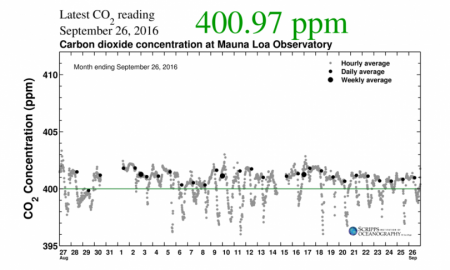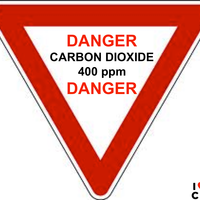October 4, 2016 – The phrase “crossing the Rubicon” dates back to Julius Caesar and his war on the Roman Senate. When told to disband his legions, Caesar chose to cross the river that was considered the boundary of Italy, the Rubicon, and call the Senate’s bluff. He won and it began the inevitable transition from Roman Republic to Empire.
The number 400 is now permanently crossed on our planet. It refers to the carbon dioxide level in the atmosphere as plotted in parts per million (ppm). Atmospheric scientists and climatologists call this a new climate era, a point in time where we will leave 400 behind and continue to climb to higher amounts. When asked if we can ever get back to 400 ppm, climatologists use the words “never again.”
This crossing we have made is being reported as the European Union approves ratification of the Paris Agreement on climate change, a global pact pledged to keep the mean average temperature of the planet from rising above 2 Celsius (3.6 Fahrenheit), and if possible no higher than 1.5 Celsius (2.7 Fahrenheit). But at 400 ppm climate scientist state we will surpass 1.5 Celsius by end of century, and only drastic cuts in carbon emissions, well beyond targets set in Paris will alter that outcome beyond century end.
In a recent analytical report on global warming its authors ask the question “is it possible to return warming to below 1.5 Celsius within this century?” The conclusion is this could be achievable by reaching zero CO2 emissions between 2045 and 2065. Even then we would have to be at negative emissions after 2065 which would mean removing carbon from the atmosphere by natural and technological means.
The latency of atmospheric warming in response to above 400 ppm CO2 levels would mean temperatures would continue to rise for period well beyond the date range described above. There is no certainty on the timeline as to when we would begin to see stabilizing of temperatures followed by a decline.
The report notes “a warming limit of 1.5 Celsius requires total greenhouse gas concentrations – plus the effects of aerosols – to be below a level of 400 ppm CO2.” This is the Rubicon threshold we have already crossed. But will we see warming climb to 2 Celsius? The authors believe that a global effort to reach zero CO2 emissions in the time frame described could keep us below that warming limit.
There is, however, a closing window of opportunity. As the authors of the report state, “with every decade lost, these challenges rise and will, at some point, become insurmountable with warming locked in to 2 Celsius and above.”
Today climate change is costing the world $1.2 trillion U.S. and wiping out 1.6% of global GDP annually. In future, that number is expected to grow significantly. Any lack of concerted action by governments and industry will only further exacerbate warming impacts. And as I have reported before, there are some tipping points to warming that could produce rapid continental or oceanic changes to climate as of yet unforeseen.
Authors, Bill Hare, Michiel Schaeffer, Olivia Serdeczny and Carl Friedrich-Schleussner, are associated with the Potsdam Institute of Climate Impact Research, Climate Analytics, and Wageningen University and Research Centre.
In a more local climate change story, the federal government of Canada yesterday announced to provincial and territorial environment ministers its intention to establish a floor price on carbon pollution. It gave the provinces and territories a deadline of 2018 to adopt a price on carbon either as a tax or through a cap-and-trade scheme.
The federal floor price begins at $10 per ton in 2018 and each year thereafter rises $10 to a $50 benchmark by 2022. At the same time the federal government has indicated that its putting a price on carbon pollution is meant to be revenue neutral. Money from the levy will remain within the province or territory from which it is generated. Right now Alberta, British Columbia, Ontario and Quebec have priced carbon. Alberta’s floor price is $20 per ton starting in January of 2017 and rising to $30 in 2018. British Columbia’s carbon price stands at $30. According to Canada’s Ecofiscal Commission, the equivalent Quebec levy is $16.40 per ton at present and rising to $18 per ton by 2020 while Ontario’s carbon levy is only beginning in 2017 and is estimated to rise to $19.40 per ton by 2020.
The government’s announcement took the provinces and territories by surprise since the previous federal administration prior to last year’s election took a hands-off approach to climate change. A likely turf war is about to erupt because of this carbon pollution initiative.
Will these measures be enough to bend the CO2 and other greenhouse gas emissions curve downward in Canada? Probably not for the foreseeable future. But it is a much needed starting point that should be followed up by a continuing national discussion so that all Canadians understand the implications and impacts. For example, in the Globe and Mail’s report of this announcement this morning it indicated that the government’s carbon pollution pricing would add 11 cents to a liter of gasoline. In pointing this out the paper was telling only half the story and ignoring the fact that the money collected would be offset by reductions in other taxation areas or by government investment in green projects aimed at bending the curve faster.










